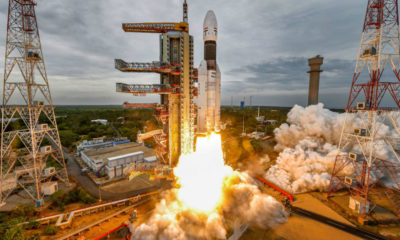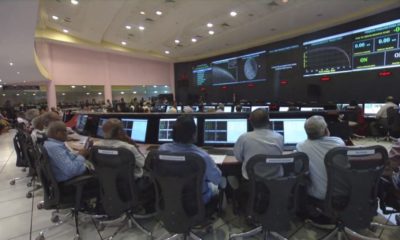Top News
ISRO launches five British satellites in copy book style

Sriharikota (Andhra Pradesh): India successfully put into orbit five British satellites with its Polar Satellite Launch Vehicle’s XL variant (PSLV-XL) on Friday night in copy book style.
This was the first commercial mission for ISRO in 2015. Exactly at 9.58 p.m., the PSLV-XL rocket, standing 44.4 metres tall and weighing around 320 tonnes, with a one way ticket tore into the night skies with fierce orange flames at its tail.
The expendable rocket carrying five British satellites cumulatively weighing around 1,440 kg as its luggage slung them into their intended orbit just over 19 minutes into its flight.
It was the heaviest commercial mission for the PSLV rocket till date though its total carrying capacity for such a mission is around 1,750 kg. The rocket blasted off from the first launch pad at the Satish Dhawan Space Centre here, about 80 km from Chennai.
For the onlookers, the rocket looked like an inverted flare/torch as it lit up the night sky amidst the cheers of the ISRO officials and the media team assembled at the rocket port here.
At the rocket mission control room, Indian space scientists at ISRO were glued to their computer screens watching the rocket escaping the earth’s gravitational pull.
Of the five British satellites, three are identical DMC3 optical earth observation satellites weighing 447 kg.
Of the other two satellites, CBNT-1 weighs 91 kg and also is an optical earth observation technology demonstration microsatellite, while the De-OrbitSail weighs 7 kg. This is an experimental nano satellite for demonstration of large thin membrane sail and drag deorbiting.
Just over 17 minutes into the flight, the rocket started ejecting the DMC3 satellites one after another and they were followed by De-OrbitSail and CNBT-1 satellites.
The whole mission was completed just over 19 minutes into the flight as planned.
Immediately on the successfully ejection, scientists at the missioncontrol centre were visibly relieved and started clapping happily.
The three DMC3 and the CBNT-1 satellites are built by Surrey Satellite Technology Ltd. The De-OrbitSail is built by Surrey Space Centre.
According to ISRO, the DMC3 constellation, comprising of three advanced mini-satellites DMC3-1, DMC3-2 and DMC3-3, is designed to address the need for simultaneous high spatial resolution and high temporal resolution optical earth observation.
Launched into a single low earth orbit plane and phased with a separation of 120 degrees between them, these satellites can image any target on the earth’s surface every day.
Major application areas include surveying the resources on earth and its environment, managing urban infrastructure and monitoring of disasters.
According to ISRO, accommodating the three DMC3 satellites each with a height of about three metres within the existing payload fairing or the heat shield of the PSLV was a challenge.
Thus, a circular L-adaptor and a triangular Multiple Satellite Adapter-Version 2 (MSA-V2) were newly designed and realised by ISRO for this specific purpose.
France’s SPOT 7 satellite weighing 714 kg was the heaviest single foreign satellite carried by a PSLV rocket till now. It was launched on June 30, 2014.
Meanwhile, ISRO is also readying for the launch of GSAT6 communication satellite using its heavier rocket Geosynchronous Satellite Launch Vehicle (GSLV).
The GSLV rocket’s first stage/engine has been assembled and the activities relating to that rocket assembly are progressing smoothly.
Only after the GSLV rocket launch the testing of a small model of reusable launch vehicle shaped like an aeroplane would be done, an ISRO official told IANS earlier.
Earlier, it was said the test reusable launch vehicle would happen in July.
Entertainment
Casino Days Reveal Internal Data on Most Popular Smartphones

International online casino Casino Days has published a report sharing their internal data on what types and brands of devices are used to play on the platform by users from the South Asian region.
Such aggregate data analyses allow the operator to optimise their website for the brands and models of devices people are actually using.
The insights gained through the research also help Casino Days tailor their services based on the better understanding of their clients and their needs.
Desktops and Tablets Lose the Battle vs Mobile
The primary data samples analysed by Casino Days reveal that mobile connections dominate the market in South Asia and are responsible for a whopping 96.6% of gaming sessions, while computers and tablets have negligible shares of 2.9% and 0.5% respectively.
The authors of the study point out that historically, playing online casino was exclusively done on computers, and attribute thе major shift to mobile that has unfolded over time to the wide spread of cheaper smartphones and mobile data plans in South Asia.
“Some of the reasons behind this massive difference in device type are affordability, technical advantages, as well as cheaper and more obtainable internet plans for mobiles than those for computers,” the researchers comment.
Xiaomi and Vivo Outperform Samsung, Apple Way Down in Rankings
Chinese brands Xiaomi and Vivo were used by 21.9% and 20.79% of Casino Days players from South Asia respectively, and together with the positioned in third place with a 18.1% share South Korean brand Samsung dominate the market among real money gamers in the region.
Cupertino, California-based Apple is way down in seventh with a user share of just 2.29%, overshadowed by Chinese brands Realme (11.43%), OPPO (11.23%), and OnePlus (4.07%).
Huawei is at the very bottom of the chart with a tiny share just below the single percent mark, trailing behind mobile devices by Motorola, Google, and Infinix.
The data on actual phone usage provided by Casino Days, even though limited to the gaming parts of the population of South Asia, paints a different picture from global statistics on smartphone shipments by vendors.
Apple and Samsung have been sharing the worldwide lead for over a decade, while current regional leader Xiaomi secured their third position globally just a couple of years ago.
Striking Android Dominance among South Asian Real Money Gaming Communities
The shifted market share patterns of the world’s top smartphone brands in South Asia observed by the Casino Days research paper reveal a striking dominance of Android devices at the expense of iOS-powered phones.
On the global level, Android enjoys a comfortable lead with a sizable 68.79% share which grows to nearly 79% when we look at the whole continent of Asia. The data on South Asian real money gaming communities suggests that Android’s dominance grows even higher and is north of the 90% mark.
Among the major factors behind these figures, the authors of the study point to the relative affordability of and greater availability of Android devices in the region, especially when manufactured locally in countries like India and Vietnam.
“And, with influencers and tech reviews putting emphasis on Android devices, the choice of mobile phone brand and OS becomes easy; Android has a much wider range of products and caters to the Asian online casino market in ways that Apple can’t due to technical limitations,” the researchers add.
The far better integration achieved by Google Pay compared to its counterpart Apple Pay has also played a crucial role in shaping the existing smartphone market trends.
Content provided by Adverloom























